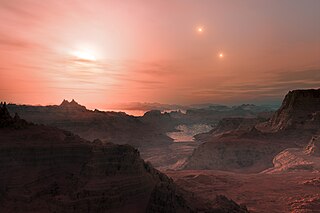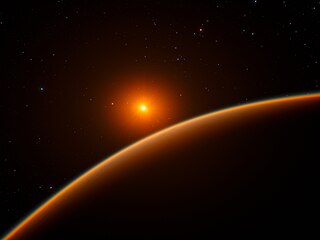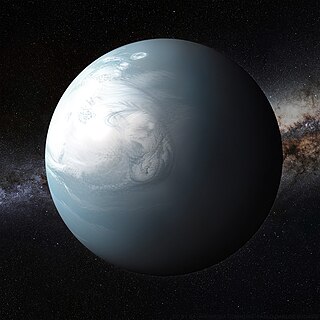Related Research Articles

A Super-Earth is a type of exoplanet with a mass higher than Earth's, but substantially below those of the Solar System's ice giants, Uranus and Neptune, which are 14.5 and 17 times Earth's, respectively. The term "super-Earth" refers only to the mass of the planet, and so does not imply anything about the surface conditions or habitability. The alternative term "gas dwarfs" may be more accurate for those at the higher end of the mass scale, although "mini-Neptunes" is a more common term.

An exoplanet is a planet located outside the Solar System. The first evidence of an exoplanet was noted as early as 1917, but was not recognized as such until 2016; no planet discovery has yet come from that evidence. What turned out to be the first detection of an exoplanet was published among a list of possible candidates in 1988, though not confirmed until 2003. The first confirmed detection came in 1992, with the discovery of terrestrial-mass planets orbiting the pulsar PSR B1257+12. The first confirmation of an exoplanet orbiting a main-sequence star was made in 1995, when a giant planet was found in a four-day orbit around the nearby star 51 Pegasi. Some exoplanets have been imaged directly by telescopes, but the vast majority have been detected through indirect methods, such as the transit method and the radial-velocity method. As of 1 March 2024, there are 5,640 confirmed exoplanets in 4,155 planetary systems, with 895 systems having more than one planet. This is a list of the most notable discoveries.

Gliese 667 Cc is an exoplanet orbiting within the habitable zone of the red dwarf star Gliese 667 C, which is a member of the Gliese 667 triple star system, approximately 23.62 light-years away in the constellation of Scorpius. The exoplanet was found by using the radial velocity method, from radial-velocity measurements via observation of Doppler shifts in the spectrum of the planet's parent star.

HD 40307 g is an exoplanet candidate suspected to be orbiting in the habitable zone of HD 40307. It is located 42 light-years away in the direction of the southern constellation Pictor. The planet was discovered by the radial velocity method, using the European Southern Observatory's HARPS apparatus by a team of astronomers led by Mikko Tuomi at the University of Hertfordshire and Guillem Anglada-Escude of the University of Göttingen, Germany.

Kepler-62e is a super-Earth exoplanet discovered orbiting within the habitable zone of Kepler-62, the second outermost of five such planets discovered by NASA's Kepler spacecraft. Kepler-62e is located about 990 light-years from Earth in the constellation of Lyra. The exoplanet was found using the transit method, in which the dimming effect that a planet causes as it crosses in front of its star is measured. Kepler-62e may be a terrestrial or ocean-covered planet; it lies in the inner part of its host star's habitable zone.
Kepler-61b is a super-Earth exoplanet orbiting within parts of the habitable zone of the K-type main-sequence star Kepler-61. It is located about 1,100 light-years from Earth in the constellation of Cygnus. It was discovered in 2013 using the transit method, in which the dimming effect that a planet causes as it crosses in front of its star is measured, by NASA's Kepler spacecraft.

Kepler-442b is a confirmed near-Earth-sized exoplanet, likely rocky, orbiting within the habitable zone of the K-type main-sequence star Kepler-442, about 1,206 light-years (370 pc) from Earth in the constellation of Lyra.

K2-3d, also known as EPIC 201367065 d, is a confirmed exoplanet of probable mini-Neptune type orbiting the red dwarf star K2-3, and the outermost of three such planets discovered in the system. It is located 143 light-years away from Earth in the constellation of Leo. The exoplanet was found by using the transit method, in which the dimming effect that a planet causes as it crosses in front of its star is measured. It was the first planet in the Kepler "Second Light" mission to receive the letter "d" designation for a planet. Its discovery was announced in January 2015.

K2-72e (also known by its EPIC designation EPIC 206209135.04), is a confirmed exoplanet, likely rocky, orbiting within the habitable zone of the red dwarf star K2-72, the outermost of four such planets discovered in the system by NASA's Kepler spacecraft on its "Second Light" mission. It is located about 217.1 light-years (66.56 parsecs, or nearly 2.0538×1015 km) away from Earth in the constellation of Aquarius. The exoplanet was found by using the transit method, in which the dimming effect that a planet causes as it crosses in front of its star is measured.

LHS 1140 b is an exoplanet orbiting within the conservative habitable zone of the red dwarf LHS 1140. Discovered in 2017 by the MEarth Project, LHS 1140 b is about 5.6 times the mass of Earth and about 70% larger in radius, putting it within the super-Earth category of planets. It was initially thought to be a dense rocky planet, but refined measurements of its mass and radius have found a lower density, indicating that it is likely an ocean world with 9-19% of its mass composed of water, or a dense mini-Neptune. LHS 1140 b orbits entirely within the star's habitable zone and gets 43% the incident flux of Earth. The planet is 49 light-years away and transits its star, making it an excellent candidate for atmospheric studies with ground-based and/or space telescopes.
Kepler-1652b is a super-Earth exoplanet, orbiting within the habitable zone of the red dwarf Kepler-1652 about 822 light-years away in the Cygnus constellation. Discovered by NASA's Kepler spacecraft, Kepler-1652b was first announced as a candidate in 2013, but wasn't validated until four years later in 2017. It is a potential super-Earth with 160% Earth's radius. The planet orbits well within the habitable zone of its system, the region where liquid water can exist on a planet's surface. The planet is an eyeball planet candidate.
K2-141b is a massive rocky exoplanet orbiting extremely close to a K Type orange main-sequence star K2-141. The planet was first discovered by the Kepler space telescope during its K2 “Second Light” mission and later observed by the HARPS-N spectrograph. It is classified as an Ultra-short Period (USP) and is confirmed to be terrestrial in nature. Its high density implies a massive iron core taking up between 30% and 50% of the planet's total mass.
K2-229 is a K-type main sequence star approximately 103 parsecs away in the constellation Virgo. It was observed by the Kepler Space Telescope during its K2 "Second Light" mission in Campaign 10.

K2-288Bb is a super-Earth or mini-Neptune exoplanet orbiting in the habitable zone of K2-288B, a low-mass M-dwarf star in a binary star system in the constellation of Taurus about 226 light-years from Earth. It was discovered by citizen scientists while analysing data from the Kepler spacecraft's K2 mission, and was announced on 7 January 2019. K2-288 is the third transiting planet system identified by the Exoplanet Explorers program, after the six planets of K2-138 and the three planets of K2-233.
TOI-700 is a red dwarf 101.4 light-years away from Earth located in the Dorado constellation that hosts TOI-700 d, the first Earth-sized exoplanet in the habitable zone discovered by the Transiting Exoplanet Survey Satellite (TESS).
Tau Ceti f is a potential super-Earth or mini-Neptune orbiting Tau Ceti that was discovered in 2012 by statistical analyses of the star's variations in radial velocity, based on data obtained using HIRES, AAPS, and HARPS. It is of interest because its orbit places it in Tau Ceti's extended habitable zone, but a 2015 study implies that there may not be a detectable biosignature because it has only been in the temperate zone for less than one billion years. In 2017, it was again recovered from radial-velocity data, along with Tau Ceti e. Despite this, it remains an unconfirmed candidate.
Kepler-737b is a super-Earth exoplanet 669 light years away. There is a chance it could be on the inner edge of the habitable zone.

A hycean planet is a particular type of exoplanet that features a liquid water ocean under a hydrogen-rich atmosphere.
TOI-2257 b is an extremely eccentric (0.496) exoplanet in or near the circumstellar habitable zone of the star TOI-2257, 188 light-years away. It is likely a sub-Neptune exoplanet, with a mass of 5.71 Mearth and a radius of 2.19 Rearth. As a small planet in the habitable zone, it is included in the Planetary Habitability Laboratory's list of potentially habitable exoplanets.
References
- 1 2 3 "37 new validated planets in overlapping K2 campaigns" . Retrieved November 22, 2023.
- 1 2 3 "Transiting exoplanet candidates from K2 Campaigns 5 and 6" . Retrieved November 22, 2023.
- 1 2 3 4 "PHL @ UPR Arecibo - The Habitable Exoplanets Catalog". phl.upr.edu. Retrieved November 21, 2023.
- 1 2 3 4 "Exoplanet-catalog". Exoplanet Exploration: Planets Beyond our Solar System. Retrieved November 21, 2023.
- 1 2 3 4 5 "K2-332 | NASA Exoplanet Archive". exoplanetarchive.ipac.caltech.edu. Retrieved November 21, 2023.
- ↑ Koberlein, Brian; Today, Universe. "Could life exist in the atmosphere of a sub-Neptune planet?". phys.org. Retrieved November 21, 2023.
- ↑ "Properties of sub-Neptune atmospheres: TOI-270 system". academic.oup.com. Retrieved November 21, 2023.
- ↑ Barnes, Rory (December 1, 2017). "Tidal locking of habitable exoplanets". Celestial Mechanics and Dynamical Astronomy. 129 (4): 509–536. arXiv: 1708.02981 . Bibcode:2017CeMDA.129..509B. doi:10.1007/s10569-017-9783-7. ISSN 1572-9478. S2CID 119384474.
- ↑ Hu, Yongyun; Yang, Jun (January 14, 2014). "Role of ocean heat transport in climates of tidally locked exoplanets around M dwarf stars". Proceedings of the National Academy of Sciences. 111 (2): 629–634. Bibcode:2014PNAS..111..629H. doi: 10.1073/pnas.1315215111 . ISSN 0027-8424. PMC 3896211 . PMID 24379386.


